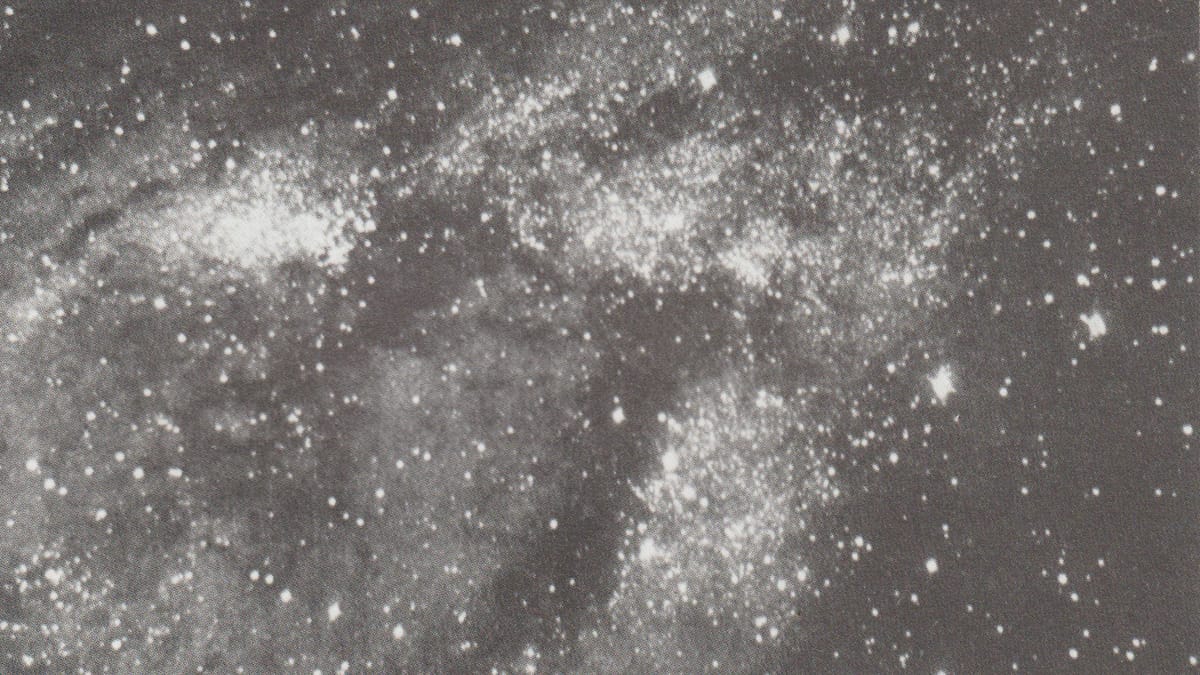The Screen of the Sky

On stargazing and the journey towards screening E. Elias Merhige’s Begotten, Din of Celestial Birds and Polia and Blastema in a planetarium
1.
For me, the journey goes back twenty-five years. Early October 1998, at the Institut français, London, where I had organised ‘A Weekend with Andrzej Żuławski’. There was an opening reception. Maria Żuławski, widow of the painter Marek Żuławski, brought a friend, Jasia Reichardt. A writer and curator, Jasia used to be director of the ICA in London, where she curated Cybernetic Serendipity, a pioneering exhibition on computer art.
She is also the niece of Franciszka and Stefan Themerson, Polish Jews who fled Poland in the 30s, settling in London in the 40s. In Poland, they had made several avant-garde films — indeed, they are synonymous with the Polish interwar avant-garde.
Jasia gave me a book by Stefan, titled The Urge to Create Visions. Based on a lecture he gave in Warsaw in 1937, it is about what cinema is and could be. During these last twenty-five years, the book has never left me. The spine has collapsed, the pages loose. It has formed the basis of workshops I have run with school children; I constantly plunder its text for quotes suggesting I am better read than I am. I have made film programmes out of it, too.
It is the opening section that intrigues me the most: a picture of the Great Nebula in Andromeda, above a quote attributed to a certain J. Dembowski:
“All that we see in the starry sky is luminous points scattered at random. And yet, the first man on earth already gathered those points into groups, drew the connecting lines, distinguished constellations, and succeeded in seeing in them resemblance to all kinds of things terrestrial. It wasn’t his eye that drew for him the shapes of lions, bears, scorpions, and swans. They are configurations imposed on reality.”
On the next page is a Bushman tale:
"You would like to know, dear Sir or Madam, who was the chap that invented cinema?
Well, my dear Sir or Madam, as a matter of fact, it wasn’t a chap. It was a girl. A girl from long ago:
‘A girl from long ago took a handful of embers and threw them up in the air; and the sparks became stars.’"
Themerson then writes the next section, titled The screen of the sky:
"The screen was high up, the immense dome standing on the edges of the flat, circular floor of the Earth. It was enough to be willing to look, to be able to see a galaxy of dramas."
Themerson rightly points out that cinema was born before Edison or Lumière:
“Poetry, long before we found a way of preserving it in written or printed characters, was recorded in human memory.
Visions, long before we found a way of developing them on cinema film, were recorded in poetry. [...]
Cinematograph. Why not: uedja for silent shadows, and loakal – for sound ones?
‘The Arawacs use the same word for shadow, soul, and picture – uedja. The Abipons have only one word: loakal for shadow, soul, echo, and picture’."
Themerson writes of how, as a student of architecture, he dreamed of a cinema with a hemispheric screen:
"Within the hemispheric screen, the spectator himself is the frame of reference."
Like star gazing, the screen of the sky had the capacity to be a frame of reference to both the representational and the abstract.
2.
When I saw E. Elias Merhige’s Polia and Blastema (2020), I thought, again, of The Urge to Create Visions. This was, after all, a film beginning with a starburst, or supernova, and the galaxy it gives birth to. In cinema, its ascendents include Stanley Kubrick’s 2001: A Space Odyssey. In literature, Olaf Stapeldon’s Star Maker.
Polia and Blastema is science fiction, but not as we know it. It reinvents the space opera as something that is less Star Wars, and more Sergei Eisenstein’s Die Walküre, his singular opera production that set out his preoccupation of myth as emerging from primordial culture. This had its roots in nineteenth century Russian symbolism, which in turn engaged with, if not Wagner, then Nietzsche’s interpretation, laid out explicitly in his 1872 work The Birth of Tragedy out of the Spirit of Music.
Polia and Blastema, in my eyes, had to be seen on a hemispheric screen.
3.
It is important not to make the mistake of thinking that, with Polia and Blastema, Merhige is segueing into the performing arts, namely opera. Rather, it is the other way around. Look at the credits of Merhige’s Begotten (1989), and it is credited to a theatre troupe, Theatreofmaterial. Begotten was a cinematic response to an envisaged performance.
4.
Merhige has talked about the influence of Antonin Artaud, and his ideas about theatre. After toying with the surrealists and making ends meet as a film actor, Artaud’s Road to Damascus experience was witnessing a production of Balinese theatre in Paris. Artaud’s flash of inspiration was to underpin much of twentieth century theatre: theatre as ritual, an act of “organised anarchy” that aims to affect the audience through the brutal awakening of their senses. He put down his ideas as theory, but, thanks to a morphine habit and schizophrenia, was unable to realise them.
His writings were rediscovered in the decades after his death – Peter Brook in England, Jerzy Grotowski in Poland, Alejandro Jodorowsky in Mexico, Carmelo Bene in Italy, Terayama Shuji in Japan.
In the US, Artaud also had his advocates, most notably Richard Schechner, and New York’s premier Francophile, Susan Sontag.
Sontag, who saw the film at the urging of, amongst others, American producer Tom Luddy, counted Begotten as one of the most important films of recent times. One can speculate that it fulfilled the Artaud dream of cinema at the service of the impossible theatre.
5.
Despite Begotten’s advocates, its reception said more about the state of marketing than the film itself.
On the one hand, it was deemed an experimental film. By 1989, however, if Experimental was a genre, nostalgically stretching back to the European avant-garde of the 1920s, and propagated by the films and filmmakers circulating around the personality of Jonas Mekas at Anthology Film Archives in New York, it was a genre in decline.
On the other hand, its grotesque spectacle was (mis)construed as a work of horror. Indeed, I frequently conflated grainy images of the character of ‘God’ in Begotten with Leatherface, antagonist of Tobe Hooper’s peerless The Texas Chain Saw Massacre.
Nevertheless, Merhige maintained that Begotten was the by-product of an envisaged performance. He also insisted that it was part of a larger work.
6.
‘Come to Poland’, Żuławski said.
This was his off-the-record response to my unashamedly naïve question, ‘how do you get actors to act like that?’
Thanks to a Polish Government Scholarship, I was, over the course of a few years, able to accrue an appreciation for theatre director and theorist Jerzy Grotowski and playwright Witold Gombrowicz, along with painter Witkacy (Stanisław Ignacy Witkiewicz) and writer Bruno Schulz. Usually received in France as surrealists, they were in fact part of what Zulawski described as something like distended romanticism, since Poland never had a surrealist movement as such. Artaud, though affiliated with surrealism, was never truly part of the movement either; yet Witkacy, Gombrowicz and Grotowski were all intuitively groping around the same “theatre as ritual” territory as Artaud.
Like a spider in a web, at the heart of this constellation was the Romantic poet Adam Mickiewicz, specifically his epic poem Dziady, our Forefathers Eve.
Dziady is a drama made up of four parts, composed in non-chronological order. This, of course, brings us back to Merhige’s trilogy — a cosmic drama made of three parts, produced out of sequence. To give a thumbnail sketch: a galaxy is born (Polia and Blastema), upon a planet of which life comes into being (Din of Celestial Birds, 2006), which gives birth to, if not tragedy, then ritual and myth, on the floor of a forest (Begotten). In essence, we begin with a macrocosm, and end with a microcosm (which, of course, was the theme of Gombrowicz’s last, great novel, Cosmos, which also served the basis of Żuławski’s final film, Cosmos, in 2015).
7.
If this three-part drama can be traced back to the inception of Begotten, then it is necessary to invoke the guiding spirits of two midwives: Aram Avakian, Merhige’s professor at State University of New York at Purchase (and co-director and editor of 1959’s Jazz on a Summer's Day, the first feature-length concert movie with live sound), and Dennis Jakob, film editor and historian. It was Jakob who described Begotten as ‘hermetic’, and who, consciously or not, shaped Merhige’s own conception of this three film cycle as being, not so much abstractions, as cyphers for the miraculous.
Aspects of this thinking permeates Merhige’s comparatively mainstream features, Shadow of the Vampire (2000), and Suspect Zero (2004).
8.
The pandemic, coupled with technological advances in streaming and the increasing corporatisation of film production and distribution, posed an existential threat to cinema as spectacle — as embodied, by, for example, 2001: A Space Odyssey.
In 2020, I sat in a private screening of a newly struck 35mm print of the Quay Brothers’ The Dolls Breath, in La Salle 500, at Forum des Images, put on exclusively for the exceptional composer Michèle Bokanowski and her husband, Patrick.
The Dolls Breath had been produced by Christopher Nolan, arguably the foremost advocate of both celluloid and the theatrical experience. A few weeks later, I experienced Nolan’s Tenet in an empty multiplex, in the outskirts of Paris.
Three years ago it was clear that cinema was either going to be subsumed by streaming, or come back in a flamboyant, outrageous manner like it did in the 1950s, when television threatened cinema, which struck back with Cinemarama experience, complete with overtures and souvenir programmes.
9.
Or, perhaps, cinema is supposed to die, and, Cambridge Ritualists style, its body devoured by the masses, and subsequently embodied as something else.
Perhaps this is the moment that Begotten, Din of Celestial Birds, and Polia and Blastema are reconstituted as raw material for a performative spectacle, with live music, drawing on not just projection, but projection mapping, where the experience of cinema is singular.
10.
Years ago, there was a moment when I was rationalising books, and I hesitated when it came to Gene Youngblood’s Expanded Cinema, a groundbreaking book which argued that for cinema to develop, it needed to incorporate both developments in technology and our changing understanding of consciousness. At the time, it seemed outdated, the road map for a cul-de-sac. I’m glad I held onto it. After Merhige’s trinity, it seems a furtive exploration of cinema as a spectacle to come.




